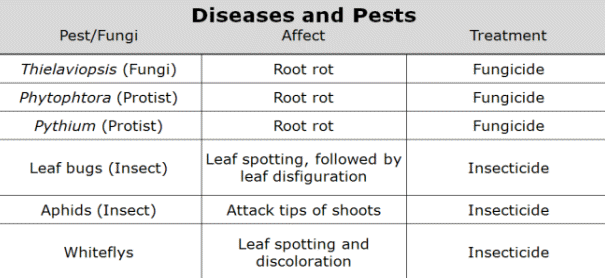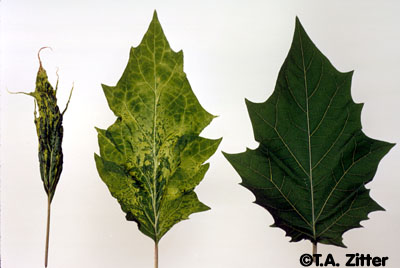Interactions
________________________________________________________
Diseases and pests
Like most
species of plants, The Datura spp. are not exempt from their
fare share harmful relationships. Specifically, certain fungi,
protists (interestingly, all of the protists listed below were
previously classified as fungi), and insects are many times to blame for harm
to the plant. The table below depicts several of these
relationships.

Although it may appear that with the use of fungicides and insecticides Datura stramonium may be protected, the reality is that the mentioned pest and diseases above are incredibly resilient and can/do appear whenever the plant is vulnerable. For these reasons, as stated in the habitat page, Daturas thrive in warm and sunny places were the soil tends to stay dry and aerated. This specified environment does not typically harbor as many of the organisms above. Also, Datura stramonium is not the only plant to suffer from these pests, orchids, along with many other plants are frequent hosts to the organisms above.
________________________________________________________
Viruses
A much more
threatening presence to the Datura sp., as well as to other
organisms, are viruses. All of the above insects can frequently
infect plants with a wide range of viruses that if left unchecked
can devastate entire populations of the species. This devastation is partially
because of Daturas relatively effective way of
reproduction. By mainly self
pollinating, Datura stramonium infected with viruses can
produce viable seeds that will in turn produce more infected plants. These attacks are characterized by many factors,
but can be identified by the wilting of leaf tips, flowers, and stalks during optimal
conditions. Some examples,
which with the reclassification of Datura spp. to Brugmansia
spp. may change, include Datura wilt virus, Datura distortion
mosaic virus, Datura rugose leaf-curl virus, and Datura quercina
virus
(Preissel and Preissel
2002).
________________________________________________________
Farm Animals/Wild
life
While jimson weed's odor and taste usually deter animals from
consuming it, on occasion it is known to happen. More commonly
however Datura stramonium is accidentally harvested and
mixed in to
livestock
feed. At this point animals mistakenly
consume the plant, rather than eating it solely to subside their
hunger. The result can be jimson weed poisoning and the effect in
animals are comparable to those listed for humans below.
________________________________________________________
Humans
A possibly surprising fact is that jimson weed is more commonly
ingested by humans than animals. Although the medicinal and hallucinogenic
properties are discussed on the facts page, the following shows
the possible effects of jimson weed poisoning. These effects as
stated before also
apply to live stock/other farm animals that consume comparable amounts of the plant to
their mass.
Early signs
- Pupil dilation
- Metabolic system abnormalities (diarrhea, anorexia, or weight
loss)
- Nervousness (rapid breathing and depression)
Late signs/fatal reactions
- Cardiovascular weakening
- Coma
- Extreme urinary retention
- Convulsions
To learn about why Datura stramonium has these effect proceed to the nutrition page
...Or return to the
home page for a fresh start.
